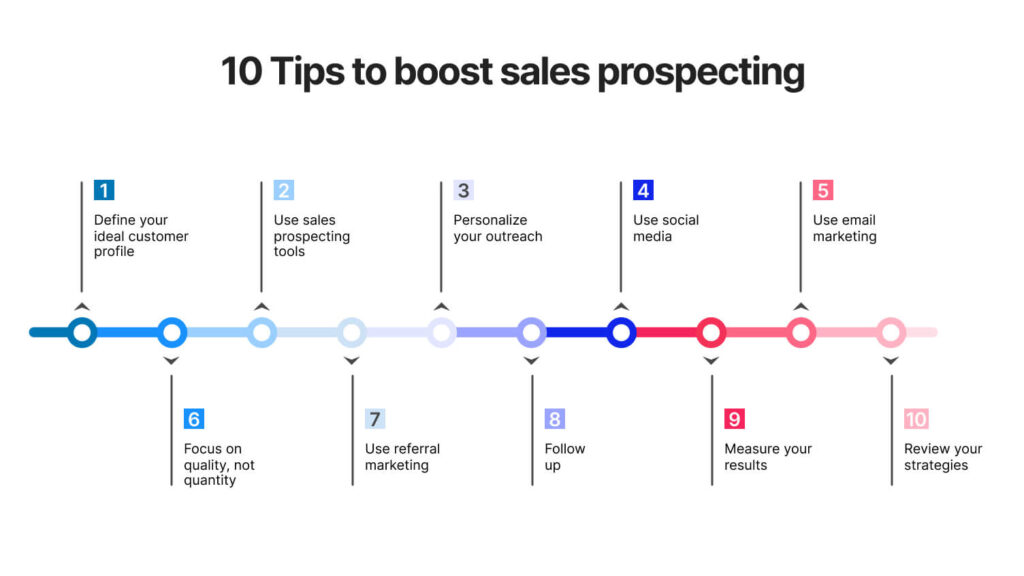Though oftentimes underestimated, sales prospecting is a crucial part of every business. This is why keeping your strategies updated is essential to guarantee business growth. In this article, we’ll discuss ten tips that can help you improve your prospecting and increase your conversion rates.
What is sales prospecting?
Prospecting is the process of identifying and engaging with potential customers to turn them into paying clients. Effective prospecting is essential for any business looking to grow and expand its customer base. According to a study by InsideSales, 46% of sales reps said that prospecting is the most challenging part of the sales process.
But what is it, anyway? Sales prospecting is the process of finding and reaching out to potential customers who are likely to be interested in your products or services. It can be done through various channels:
- LinkedIn
- Email
- Phone calls
- Face-to-face
The importance of sales prospecting
Of course, the first thing that comes into mind when we think about this topic is that prospecting is the first part of your sales cycle… The first touch-point… Key to developing a relationship and so on.
But the prospecting in companies is a lot more than that. It is crucial for any business looking to grow and expand its customer base. According to a study by Salesforce, high-performing sales teams are 1.5 times more likely to prioritize prospecting than underperforming teams.
Simply put, there is no possible business and therefore, there’s no company that can thrive out there, without a proper sales strategy. What makes a good strategy? A set of steps crafted to better fit both your team’s needs and your ICP expectations.
As you might already know, there isn’t such a thing as a perfect or typical prospecting playbook. Each company will create its own and even variations of it depending on:
- The type of market they’re reaching.
- The persona they’re engaging with.
- The deal size.
- The product they’re trying to sell.
10 Tips to improve your prospecting strategies
When it comes to strategies, then, is not to try to find pre-established templates but to get the best insights to develop your own. And this, we’ll discuss it below.
1. Define your ideal customer profile
Before you start your prospecting efforts, you need to define your ideal customer profile. This includes identifying the demographics, industry, company size, and job titles of your target customers. Defining your ideal customer profile will help you focus your efforts on the most promising leads.
2. Use sales prospecting tools
Sales prospecting tools can help you streamline your processes and improve your conversion rates. Tools such as LinkedIn Sales Navigator can provide you with valuable information on potential customers, including their job titles, company size, and industry. All of these are key to match your ICP.
3. Personalize your outreach
Personalized outreach is crucial for an effective sales process. According to a study by Experian, personalized emails have a 29% higher open rate and 41% higher click-through rate than generic emails. Personalize your messaging based on the prospect’s industry, job title, and pain points to increase the likelihood of a successful conversion.
4. Use social media
Social media can be an effective tool for sales prospecting. A report published by HubSpot, showed that social selling is the way to go for marketers worldwide. Use social media platforms such as LinkedIn, Twitter, and Facebook to identify potential customers and engage with them.
5. Use email marketing
Email marketing can be a powerful tool for sales prospecting. According to a study by Campaign Monitor, email marketing has an ROI of 4400%. Use email marketing to reach out to potential customers and provide them with valuable information about your products or services.
6. Focus on quality, not quantity
Focusing on quality, not quantity, is crucial for effective sales prospecting. When reaching out to potential customers, According to Ascend, improving lead quality is the most important goal by 77% of marketers. Focus on identifying and engaging with high-quality leads to increase your conversion rates.
7. Use referral marketing
According to a study by Nielsen, there is nothing more powerful than a happy customer, because happy customers spread the happy word. In fact, 91% of B2B buyers are influenced by word-of-mouth when making their buying decision, while the referral-based sale closing ratio stands at 50% to 70%.
8. Follow up
Following up is essential for effective sales prospecting. According to a study by Marketing Donut, 80% of sales are made after the fifth contact. Follow up with potential customers to remind them of your products or services and answer any questions they may have.
9. Measure your results
Measuring your results is essential for refining your sales prospecting techniques over time. Use metrics such as response rates, conversion rates, and revenue generated from each prospect to identify areas for improvement and refine your sales prospecting techniques.
10. Review your strategies
Once you’ve found out that a sales prospecting strategy works, it doesn’t mean that the process is set in stone. As your company grows and evolves, so do your products, sales, and marketing efforts. It is always mandatory to periodically review what is going on in your prospect teams, even if you are getting great results.
Stepping up your sales prospecting efforts can seem challenging, but with these quick tips, you’ll be able to go back to your desk and find new opportunities to boost your sales game!

